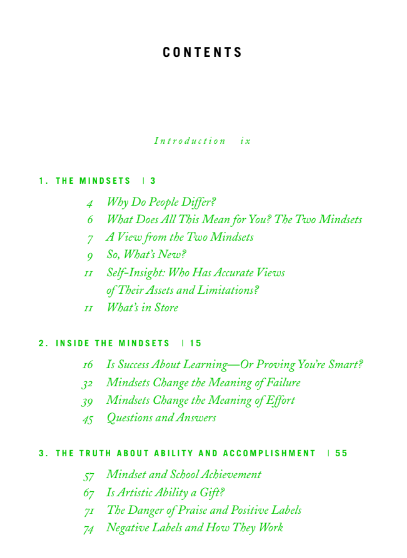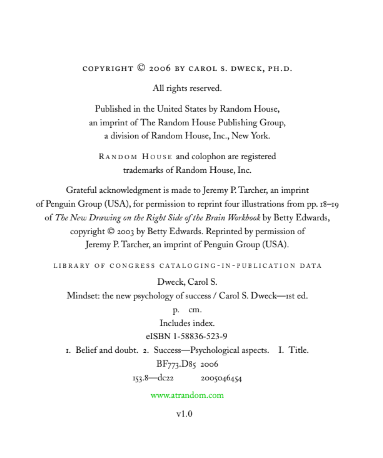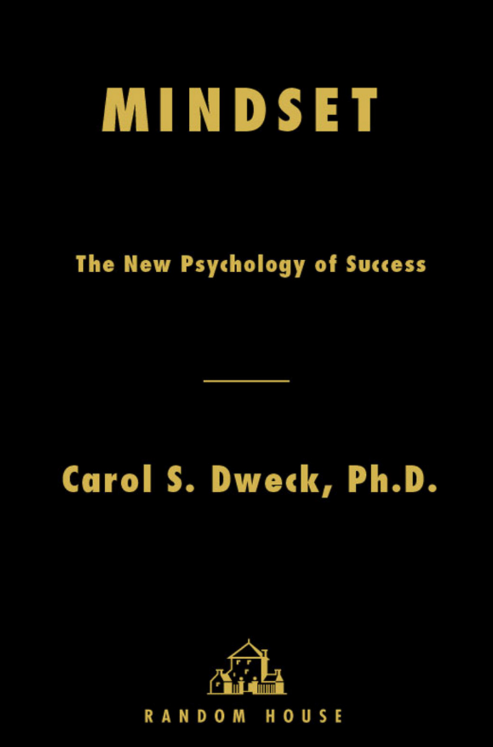


One day, my students sat me down and ordered me to write this book. They wanted people to be able to use our work to make their lives bet- ter. It was something I’d wanted to do for a long time, but it became my number one priority. My work is part of a tradition in psychology that shows the power of people’s beliefs. These may be beliefs we’re aware of or unaware of, but they strongly affect what we want and whether we succeed in getting it. This tradition also shows how changing people’s beliefs—even the sim- plest beliefs—can have profound effects.
In this book, you’ll learn how a simple belief about yourself—a belief we discovered in our research—guides a large part of your life. In fact, it permeates every part of your life. Much of what you think of as your per- sonality actually grows out of this “mindset.” Much of what may be pre- venting you from fulfilling your potential grows out of it. No book has ever explained this mindset and shown people how to make use of it in their lives. You’ll suddenly understand the greats—in the sciences and arts, in sports, and in business—and the would-have- beens. You’ll understand your mate, your boss, your friends, your kids. You’ll see how to unleash your potential—and your children’s. It is my privilege to share my findings with you. Besides accounts of people from my research, I’ve filled each chapter with stories both ripped from the headlines and based on my own life and experience, so you can see the mindsets in action. (In most cases, names and personal information have been changed to preserve anonymity; in some cases, several people have been condensed into one to make a clearer point.
A number of the exchanges are re-created from memory, and I have rendered them to the best of my ability.) At the end of each chapter and throughout the last chapter, I show you ways to apply the lessons—ways to recognize the mindset that is guiding your life, to understand how it works, and to change it if you wish. A little note about grammar. I know it and I love it, but I haven’t al- ways followed it in this book. I start sentences with ands and buts. I end sentences with prepositions. I use the plural they in contexts that require the singular he or she. I’ve done this for informality and immediacy, and I hope that the sticklers will forgive me. I’d like to take this chance to thank all of the people who made my research and this book possible. My students have made my research career a complete joy.
I hope they’ve learned as much from me as I’ve learned from them. I’d also like to thank the organizations that supported our research: the William T. Grant Foundation, the National Science Foundation, the Department of Education, the National Institute of Mental Health, the National Institute of Child Health and Human Development, and the Spencer Foundation. The people at Random House have been the most encouraging team I could wish for: Webster Younce, Daniel Menaker, Tom Perry, and, most of all, Caroline Sutton, my editor. Your excitement about my book and your great suggestions have made all the difference. I thank my su- perb agent, Giles Anderson, as well as Heidi Grant for putting me in touch with him. Thanks to all the people who gave me input and feedback, but spe- cial thanks to Polly Shulman, Richard Dweck, and Maryann Peshkin for their extensive and insightful comments. Finally, I thank my husband, David, for the love and enthusiasm that give my life an extra dimension. His support throughout this project was extraordinary. My work has been about growth, and it has helped foster my own growth. It is my wish that it will do the same for you.
Wasn’t the IQ test meant to summarize children’s unchangeable in- telligence? In fact, no. Binet, a Frenchman working in Paris in the early twentieth century, designed this test to identify children who were not profiting from the Paris public schools, so that new educational programs could be designed to get them back on track. Without denying individual differences in children’s intellects, he believed that education and prac- tice could bring about fundamental changes in intelligence. Here is a quote from one of his major books, Modern Ideas About Children, in which he summarizes his work with hundreds of children with learning difficulties: A few modern philosophers . . . assert that an individual’s intelligence is a fixed quantity, a quantity which cannot be increased.
We must protest and react against this brutal pessimism…. With practice, training, and above all, method, we manage to increase our attention, our memory, our judgment and literally to become more intelligent than we were before. Who’s right? Today most experts agree that it’s not either-or. It’s not nature or nurture, genes or environment. From conception on, there’s a constant give and take between the two. In fact, as Gilbert Gottlieb, an eminent neuroscientist, put it, not only do genes and environment coop- erate as we develop, but genes require input from the environment to work properly.
At the same time, scientists are learning that people have more capacity for lifelong learning and brain development than they ever thought. Of course, each person has a unique genetic endowment. People may start with different temperaments and different aptitudes, but it is clear that experience, training, and personal effort take them the rest of the way. Robert Sternberg, the present-day guru of intelligence, writes that the major factor in whether people achieve expertise “is not some fixed prior ability, but purposeful engagement.” Or, as his forerunner Binet recognized, it’s not always the people who start out the smartest who end up the smartest.


